|
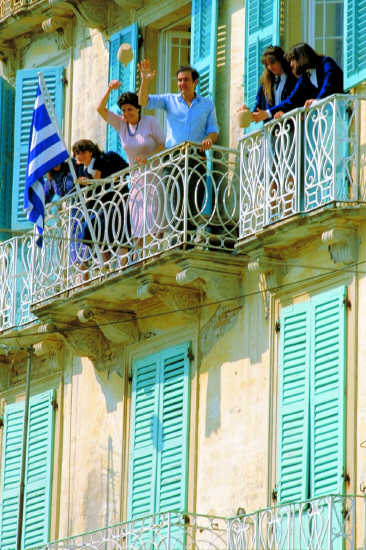
Corfu, which is identified as the Homeric island of the Phaeacians, Odysseus' penultimate
stop on his voyage home to Ithaca (Odyssey vi), is one of the best-known and most highly developed tourist islands in the
Medi terranean. Its natural beauty and mild climate, many places of interest, sparkling sea , ultra-modern
hotels, abundant
opportunities for entertainment and sports, its combination of a cosmopolitan character and couleur locale, its aristocratic
town and picturesque villages are the principal poles of attraction for visitors.
The northernmost of the Ionian Islands,
Corfu is 611 sq. km. in area and has 200 km. of coastline. Its terrain is fertile, with lush vegetation and lots of water,
vast olive groves, vineyards, pine forests, orchards of fruit trees and vegetable gardens.
The geomorphology of the coastline varies. Steep, rocky cliffs on the west and gentle
shores on the east and north, ending in tranquil bays in which the greenery of the land is reflected in the limpid waters
of the Ionian Sea.
Human habitation can be traced back to the Palaeolithic Age but the island enjoyed a particular heyday
in the eighth century BC and was enhanced as a great maritime and mercantile power later.
During the Peloponnesian War
it allied with the Athenians but later came under
Spartan influence. From 229 BC to AD 337 Coreyra was occupied by the
Romans. In 1537 it suffered a devastating attack by Barbarossa.
In more recent times the island experienced many conquerors
(Venetians, Russians, Ottomans, French, British and Italians), which largely explains the diversity of its monuments, witnesses
to the long and troubled course of the island 's history. On 21 May 1864 Corfu was united with Greece, along with
the other
Ionian Islands, while during World War II the town of Corfu was badly damaged by incendiary bombs.
Corfu has a splendid
cultural tradition, particularly in the Arts and Letters , which continue to be cultivated to this day.
THE TOWN
The island 's capital and port, of the same name, is located
in about the midpoint of the east coast, opposite Epirus on the mainland. It is the largest medieval city in Greece still
inhabited and one of the loveliest in the Mediterranean. The medley of cultural traits endows this Eptanesian town with its
unique noble ambience, with a particular charm.
Quite fascinating are the foreign architectural influences and the various
orders that are blended with the local vernacular features and the spectacular natural landscape, creating an aesthetic result
sans pareil.
Sights in the town
The town of Corfu has one of the largest public squares in Greece, the impressive Spianada, the left
side of which is dominated by the magnificent Liston building complex with its distinctive arcades, a meeting place for locals
and visitors. On the north side of the Spianada stands the palace of Sts Michael and George, which dates from the period of
British rule (1814-1824), while on the west looms the imposing and intriguing Venetian Old Fort, constructed on a peninsula
in the fifteenth century.
Of interest too are the New Fort, built on St Mark's hill in the sixteenth-seventeenth century,
and the buildings of the Town Hall (17th c.), the Ionian Academy and the Ionian Parliament, the Reading Society (the oldest
intellectual foundation in modern Greece) and the old Prefecture headquarters (Capodistrias uilding - 1832), which now
house the offices of the Ionian University.
It is worthwhile wandering throug h the quarters of the town: Kampielo, the
oldest neighbourhood, with Venetian kantounia (narrow cobbled streets); Mouraya, one of the prett iest neighbourhoods by the
seaward walls of the city; Mantouki near the new harbour; Omvriaka , the old Jewish quarter; Saroko Squa re, the centre
ofthe new town; Garitsa Bay with its quaint alleyways, detac hed houses and two-storey residences, where the Menekrates Monument
is located.
Of the town 's churches, the most famous is that of St Spyridon (1859) , on account of the presence of the
sacred relic of the town's patron saint and the distinctive campani le. Important too are the churches of Sts Jason and Sosipater
in the Anemomylos (windmill) quarter, a Byzantine cross -in-square church with octagonal dome (loth c.), the Greek Orthodox
cathedral of the Virgin Spiliotissa or St Theodora ( 1577), the Platytera monastery at Mantouki (18th c.), which houses
the
tomb of thc first Governor of Greece, I. Capodistrias, the Virgin of Foreigners (1689), the Roman Catholic (duomo) cathedral
of St James in Town-Hall Square and others.
The Archaeological Museum (tel. 26610-30.680), the Museum of Byzantine and
Postbyzantine
Art in the church of the Virgin Antivouniotissa, the Museum of Asian Art (Palace of Sts Michael and George, tel. 26610-30.443),
and the Museum of Dionysios Solomos (tel. 2661030.674) all merit a visit. Three kilometres from the centre of the town is
Mon Repos, initially the summer residence of the British Governor-General of the island and later the summer palace of the
Greek royal family. The Palaiopolis basilica, also known as the basilica of St Kerkyra (5th c.) is nearby. On Analips is Hill,
ruins of a Doric temple from the 6th century BC and a fountain (Kardaki) were found, as well as the monastery of Sts Theodores
and the ruins of the temple of Artemis (6th c.
BC), 10 which the Archaic pedime nt with the Gorgo n belonged (now in the
Corfu Archaeological Museum). Kanoni at the edge of the peninsula (Halikopoulos Lagoon), south of the town, is a modem tourist
resort, linked by a little bridge to
the islet on which the much-photographed Virgin of Vlahema monastery stands. A short
distance away is densely woode d Pontikonisi, with the Byzantine chapel of Christ Pantocrator (13th c.) in the midst of the
greenery.

THE ISLAND
South of the town, on the east coast of the island, are lovely villages with lush vegetation, fine
beaches, accommodation for tourists and places of interest: Perama, a suburb of the town with tourist infrastructure; Gastouri
with the splendid palace of Empress Elisabeth of Austria (Sissy), the 'Achilleion' (1890), which is now a museum (tel.
26610-56.245); Moraitika, Mesongi , Boukaris, Korakades; Lefkimmi, a large town built in a fertile plain, the tourist village
of
Kavos and Asprokavos, the southernmost locality on the island. To the north of the town, again on the east coast, are
some of the island's most cosmopolitan and well-appointed resorts, frequented by large numbers of tourists. These are Kontokali
with luxury hotels and restaurants, Dasia, Ypsos, Pyrgi with the uniquely beautiful neighbouring village of Aghios Markos,
Barbati, Aghios Stephanos and others. On the north side of the island, where Mt. Pantokrator (911 m. asl) is situated, are
Kassiopi, centre of the region, with the ruins of a Byzantine castle, Roda and Aharavi, a sizeable tourist resort. The west
side of the island also offers interesting spots to visit. The holiday resort of Sidari, with its peculiar rock formations,
and picturesque Peroulades with its rich architectural heritage from the Venetian period and the gorgeous beach of "Canal
d'arnour" ("Love Canal") essentially are part of the same settlement. Aphionas, built on a small peninsula, has a wonderful
view of the bay of Ai-Yorgis as well as of the open sea. The traditional village of Krini is close to the Byzantine fortress
of Angelokastro, built by the despots of Epirus in the thirteenth century. The locality
"Bella Vista", as its name indicates,
offers an amazing view. Not far from here is renowned Palaiokastritsa with clear cool water in its beautifully formed bays,
a verdant landscape and the historical monastery dedicated to the Virgin Palaiokastritsa (1225). Next come the villages of
Lakones, Liapades and Ermones, built in the recess of a closed bay. Quite near the coast is the Ropa Valley with a golf course.
A height in the picturesque village of Pelekas offers a breathtaking view and a memorable sunset. At the tip of the bay of
Ai Gordis are the villages of Ano and Kato Gerounas, and further south Aghios Matthaios (or Ai Mathias), a main village with
typical Eptanesian architecture. Not far away is the monastery of Christ Pantocrator (4th c.). Also in this area are the ruins
of Gardiki Castle (13th c.) and farther south is the Korissia Lagoon (60 ha.), of unrivalled natural beauty. The island's
interior holds many surprises. Gorgeous villages in idyllic green countryside, with well-kept traditional houses, charming
churches
and flower-tilled gardens: Karousades (40 km. northwest of Corfu town), a picturesque main village with the characteristic
'Pyrgos ' (tower); Aghii Douli; Ano Korakiana (18 km. north of the town) with a famous brass band and numerous notable churches;
Skripero, with old mansions and a significant folklore tradition; Zygos (23 km. north of the town), with the church of the
Sicilian St Agatha (1536); Nymphes, with abundant water and greenery; Episkepsi (44 km. north of the town), a large village
in the midst of a wood of olive and pine trees. On the slopes of Mt Pantokrator, with magnificent views, are the villages
of Strinylas, Sgourades, Spartilas and others.
BEACHES
Scores of beaches, to satisfy even the most
demanding visitor, punctuate the island's coast. We mention indicatively: On the east coast (from N to S): Kerasia , Kouloura,
Nisaki, Barbati, Dasia, the wider area of Kommenos, busy Benitses, Aghios loannis Sidari, Petroulades and so on. On the west
coast (from N to S): Arillas, a fabulous beach with fine sand and tiny deserted islets scattered in the sea, the famous Palaiokastritsa,
Ermones, Myrtiotissa, Glyfada, one of the bestknown seaside resorts on the island, and neighbouring Kontos Yalos, very lovely
Yaliskari, Ai Gordis with tine sand and curious rocks, Halikounas and many more.
EVENTS - OTHER INFORMATION
Corfu is the venue of many festivals, religious feasts
and cultural events: Litany of St Spyridon four times a year, accompanied by the brass band; anniversary of the Union of the
Ionian Islands with Greece (2I May); Easter celebrations with the
local custom of smashing jugs by throwing them from the
balconies, on Easter Saturday; Carnival in the town of Corfu and in many villages; the International "Ionian Concerts" Music
Festival (I -30 July) , which is held within the framework of the International Summer Musical Academy by the Municipality
of Corfu, the brass band "Melos Brass" and the Department of Musical Studies of the Ionian University, and comprises concerts
of both classical and modem music, as well as theatre, dance and opera performances; the Cricket Tournament in the summer;
the 'Sound and Light' spectacle (May-September) in the Old Fort; folklore festivals in Lefkimmi with local dance s (July).
Traditional patronal feasts are also celebrated on the saints' days in the island 's villages. Corfu offers all kind of eateries,
with good food and local specialities (sofrita (braised steak), pastitsada (macaroni pie), bourdeto (meat stew) etc.), as
well as places of entertainment and amusement for all tastes. Local products include wine, oil, ginger beer, kum-quat (glace
fruit and liqueur), nougat (mandolata ), gruyere-type cheese. In the harbours of Corfu and of Palaiokastritsa there are stations
for
refuelling yachts and replenishing water supplies.
NEARBY ISLANDS
At the entrance of the harbour of Corfu lies the islet of Vidos,
which was known as Ptyhia in Antiquity. A few nautical miles northwest of Corfu is the tiny archipelago of the Diapontian
Isles (Ereikoussa, Mathraki, Othoni). Ereikoussa (4.5 n.m. from Sidari), with a few rooms to let and a small hotel, is ideal
for a quiet vacation. Mathraki (4 n.m. from the northwest coast, opposite Arillas) has lovely beaches with fine sand. Othoni
(7.5 n.m. northwest of Corfu) is identified as the place where Odysseus met Nausica. There are two settlements with a few
rooms to let. Caiques from Sidari and Arillas bring visitors to the Diapontian Islands.
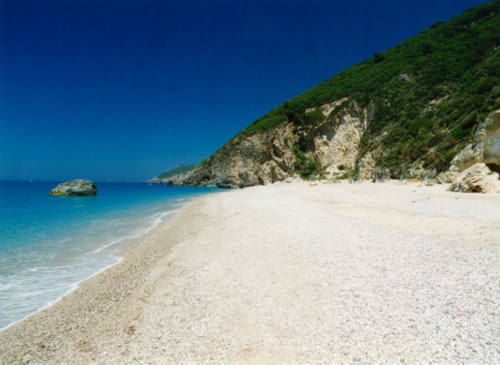

|
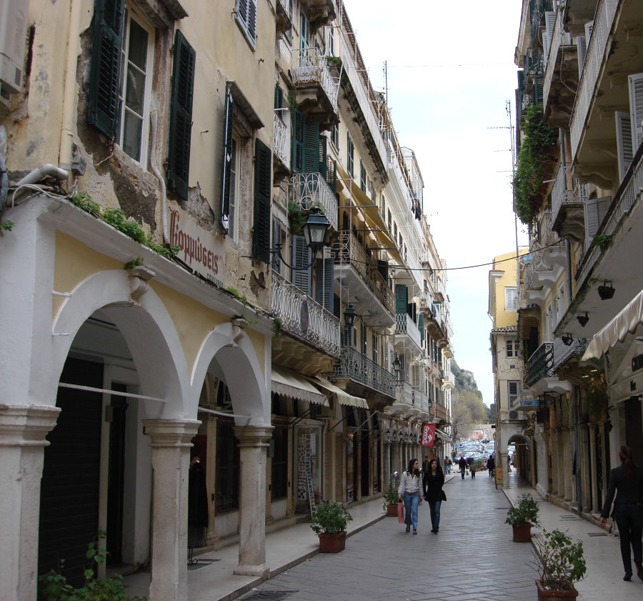
Corfù, identificata con l'omerica isola dei Feaci, I' ultirna tappa nel viaggio di Ulisse verso
Itaca (Odissea, VI), è una delle isole del Mediterraneo più conosciute e maggionncnte valorizzate dal punto di vista turistico.
Le sue bellezze naturali ed il elima mite, Ie acque meravigliose, gli alberghi ultramoderni, la grande offerta perdivertimento
e sport ed il suo carattere cosmopolita, in combinazione al colore locale, così intenso, con la città signorile ed i
suoi pittoreschi paesini, sono i principali poli di attrazione per il visitatore. E l'isola più settentrionale dello lonio,
con una superficie di 611 km2 ed una lunghezza di coste di 200 km. II suolo è fertile, con ricca vegetazione ed abbondanti
acque correnti, sconfinati oliveti, vigneti, pinete e orti con alberi da frutta e ortaggi . Le sue coste presentano una notevole
varieta nella confonnazione. Quelle occidentali sono piuttosto scoscese e rocciose; quelle orientali e quelle settentrionali
terminano dolcemente in golfi tranquilli, dove il verde della terrafenna si rispecchia nelle acque trasparenti della lonio.
Abitata fin dall' età paleolitica, conobbe la sua maggiore fioritura nel VIII sec. a.C; successivamente divenne una grande
potenza marittima e commerciale. Durante la Guerra del Peloponneso si alleò con Atene, ma poi, si trovo sotto I'influenza
di Sparta. Dal 229 a.C. al 33 7 d.C. fu sotto la dominazione romana. Nel 1537, subi una catastrofica incursion e da parte
del Barbarossa. In età moderna l'isola conobbe molti occupatori (veneziani, russi, turchi , francesi, inglesi e italiani).
Questo spiega la varietà dei suoi monumenti, che nel contempo testimoniano il lungo ed agitatissimo cammino storico dell '
isola. II 21 Maggio 1864, fu annessa alla Grecia insieme alle rimanenti Isole lonie. Durante la Seconda Guerra Mondiale, la
città di Corfu subì notevoli distruzioni a causa dei bombardamenti. L'i sola ha una notevole tradizione nelle arti, nelle
lettere e nella cultura, che ancora oggi continuano ad essere coltivate.
LA CITTA
L'omonimo capoluogo è porto principale dell' isola, si trova quasi al
centro della costa orientale, di fronte all' Epiro . E la maggiore città medievale in Grecia, piena di vita, ed una delle
più belle del Mediterraneo. La mescolanza degli elementi culturali attribuisce un particolare fascino a questa città eptanesiaca,
con l' abbondante signorilità e I'atmosfera unica . Interessanti sono gli influssi architettonici stranieri ed i vari stili,
che si armonizzano con il colore locale e I'eccellente ambiente naturale, così da creare un perfetto risultato estetico.
SITI INTERESSANTI NELLA CITTA'
Nella città di Corfu, esiste una delle maggiori piazze in Grecia, la sorprendente Spianada, sui cui
lato occidentale, domina l'imponente complesso edilizio Listòn, con Ie caratteristiche arcate, punto di incontro degli abitanti
e dei visitatori. Sui lato settentrionale della piazza, si trova il palazzo dei Santi Michele e Giorgio, una costruzione del
periodo del protettorato inglese (1814- 1824) e sul lato
orientale, domina la Vecchia Fortezza veneziana, imponente ed
affascinante, costruita nel XV secolo su una penisoletta.
Particolare interesse presentano la Nuova Fortezza, costruita
sulla collina di S. Marco, nel XVI -XVII secolo e gli edifici del Municipio (opera del XVII sec), dell'Accademia Ionia e del
Parlamento lonio, della Società di Lettura (la più antica istituzione culturale delIa Grecia moderna) e della vecchia Prefettura
(Palazzo di Kapodistrias - 1832), dove oggi hanno sede gli uffici dell' Università Ionia. Vale la pena visitare vari quartieri
della città: Kampielo, quello più antico con i kantounia veneziani (vicoletti lastricati); Mouraya, tra i più belli, sulle
mura costiere della città; Mantouki (vicino al nuovo porto); Omvriaki, il vecchio quartiere ebraico; piazza Saroko, il centro
della città nuova nella baia di Garitsa con i pittoreschi vicoletti, Ie case unifamiliari a due piani, dove si trova il monumento
di Menecrate. Tra Ie chiese della città la più famosa è quella di Agios Spiridon (Santo Spiridone 1859). dove si conservano
le reliquie del patrono della città. con il singolare campanile. Da ricordare so no anche la chiesa di Agii lason e Sosipatros
(S.ti Giasone e Sosipatro), nella zona di Anemomylos, una chiesa bizantina a pianta rettangolare a croce inscritta e
cupola ottagonale (X sec.), la
Cattedrale di Panagia Spiliotissa o Agia Theodora (S. Teodora 1577), il monastero
di Platitera a Mantouki (XVIII sec .), dove si trova la tomba del primo governatore della Grecia, I. Kapodistrias, la chiesa
Panagiaton Xenon (Madonna dei Forest ieri, 1689). La cattedrale cattolica di Agios lakovos (S . Giacomo. duomo), nella piazza
del Municipio, ed altre. Di notevole interesse sono anche
il Musco Archeologico (tel. 2661030680). il Museo di Arte
Bizantina e Post-bizantina nella chiesa di Panagia Antivouniotissa. il Museo di Arte Asiatica (Palazzo dei Santi Michele e
Giorgio. tel. 2661030.443). il Museo di Dionisios Solomos (tel. 2661030.674 ). A 3 km dal centro della città, si trova il
Mon Repos inizialmente residenza estiva del governatore inglese e successivamente della farniglia reale greca: nella stessa
zona è situata anche la basilica di Paleopolis, nota anche come Agia Kerkira (V sec . circa). Sulla collina di Analipsi. sono
state rinvenute le rovine di un tempio in stile dorico del VI sec. a .C. ed una fontana (Kardaki). il monastero di Agii Theodori
e vicino, Ie rovine del tempio di Artemide (VI sec. a.C). cui appartiene il frontone arcaico della Gorgone (Museo Archeologico).
Kanoni, all'estremità della penisola (laguna di Halikiopoulos ), a sud della città è un moderno centro di villeggiatura, ed
un piccolo ponte la collega ad un isoletta dove si trova il monastero di Panagi a Vlachernon, Ira i più fotografati . A breve
distanza, è situato il lussureggiante Pontikonissi con la cappella bizantina del Cristo Pantocrator (X III sec.).
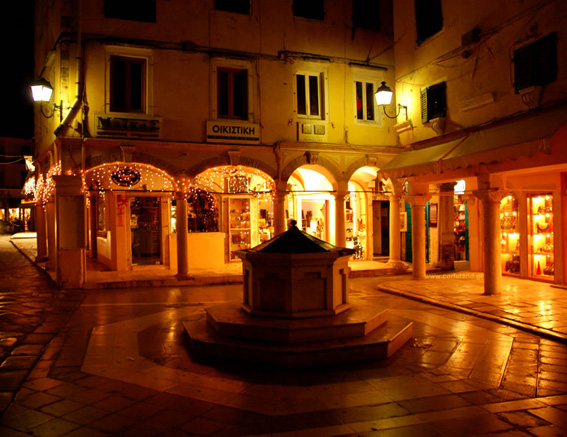
L'ISOLA
A sud della città sulla costa orientale dell' isola si trovano bei paesini
immersi nel verde, belle spiagge, molti alloggi turistici e varie località interessanti: Perama, quartiere periferico
della città con infrastrutture turistiche, il bellissimo Gastouri, con l' imponente palazzo dell 'imperatrice d 'Austria Elisabetta.
l' "Achilieion" (1890), oggi tra sformato in museo (tel. 2661056.245 ), Moraitika, Mesongi, Boukaris, Korakades, Lefkimi,
una grande cittadina situata in una fertile
pianura, Kavos, rinomato centro turistico e Asprokavos, la località più meridionale
dell'isola.
A nord della città, sempre sulla costa orientale, ci sono alcuni tra i
più mondani luoghi di villeggiatura di
Corfu, con grande movimento e nurnerose infrastrutturc turistiche. Si tratta di Kontokali. Gouvia, dove è operante uno dei
maggiori porticcioli per imbarcazioni da diporto del Mediterraneo, con una capienza di 1.000 ormeggi (tel. 2661091.376), il
mondano Komeno con lussuosi
alberghi e ristoranti. Dasia, lpsos, Pirgì con il vicino paese di Agios Markos, di una bellezza
unica, Barbati. Agios Stefanos. ed altri. Nella parte settentrionale dell' isola dove si trova il monte Pantokrator (alt.
911 m. dal livello del mare), è situata Kassiopi, centro della regione, con rovine di un castello bizantino, Roda e Aharavi,
una sviluppata località turistica. La parte occidentale dell ' isola, offre anchessa interessanti località da visitare. II
centro di villeggiatura di Sidari, con Ie sue singolari formazioni rocciose ed il pittoresco paesino di Peroulades, la cui
architettura risale al periodo della dominazione veneziana e la fantastica spiaggia. chiamata "Canale dell'Amore" (Kanali
tou Erota) che sono, essenzialmente, parte della stessa zona. Afionas, che sorge su di una piccola penisola, con una meravigliosa
veduta sulla baia di Ai-Yorgis e sui mare aperto. Vicino al tradizional e paesino di Krini, si trova la fortezza bizantina
di Angelokastro, costruita nel
XIII secolo, dai despoti de ll'Epiro. Un sorprendente panorama si può ammirare
dal
punta chiamato, a buon ragione, "Bella Vista" A breve distanza si trova la famosa Paleokastritsa, con Ie sue fresche acque
cristalline nelle insenature dalle
forme molto belle, il paesaggio verde e l'omonimo monastero storico, dedicato alla Madonna
di Paleokastritsa (1225). Di seguito, ci sono i paesini Lakones, Liapades ed Ermoncs, situati nella parte più interna di una
baia profonda . A breve distanza dalla costa, si trova la valle di Ropas, con iI campo da golf. Da un'altura, nel pittoresco
paesino di Pelekas, si gode di una meravigliosa veduta ed un tramonto unici. All'estremità della baia di Ai Gordis, sorgono
i paesini di Ano e Kato Garounas e più a sud, di Agios Matheos (o Ai Mathias), un grosso paese dalla caratteristica architettura
eptanesiaca. A breve distanza, si trova il monastero di Cristo Pantocrator (IV sec.). Sempre in questa zona, ci sono Ie rovine
del Castello di Gardiki (XII sec.), e più a sud la laguna Korissia (con una superficie di 600 ettari), di una bellezza naturale
unica. L'entroterra dell 'isola offre molte sorprese. Bellissimi paesini in un idilliaco paesaggi o lussureggiante, con case
tradizionali ben tenute, belle chiese e giardini tutti in fiore: Karousades (40 km a nord -ovest della città) , un pittoresco
paese con il caratteristico "Pyrgos" (torre), Agii Douli, Ano Kora kiana (18 km a nord della città), con una famosa Orchestra
Filarmonica e un gran numero di notevoli chiese, Skripero, con vecchie dimore signorili ed un importante tradizione folcloristica,
Zigos (23 km a nord della città), con la chiesa della sicilia na Sant' Agata (1536), Nimfes, ricco di
acque e di verde,
Episkepsi (44 km a nord della città), un grande paese situato in un basco di olivi e di pini domestici. Alle pendici del monte
Pantokrator, con una
veduta splendida, sorgono i paesini di Strinilas, Sgourades, Spartilas, ed altri.
SPIAGGE
Decine
di spiagge, che soddisfano anche il visitatore più esigente, sono
sparse lungo tutta la linea di costa dell' isola. A livello
indicativo possono essere riportate: sulle coste orientaIi (da nord a sud), Kerasia , Kouloura, Nisaki,
Barbati, Dasia,
la zona circostante di Komenos. Benitses, piena di vita, Agios loannis Sidari , Petroulades, ed altre ancora. A nord (da est
ad ovest): Aharavi (Roda) che raccoglie multi turisti, l'unica spiaggia di Sidari, Peroulades, ed altre ancora Nella parte
occidentale (da nord a sud): Arillas, una spiaggia favolosa, con sabbia sottile e piccoli isolotti de serti, sparsi nel mare. la
famosa spiaggia di
Paleokastritsa, Ermones, Mirtiotissa, Glifada, uno dei luoghi di villeggiatura piu noti dell' isola,
la vicina spiaggia Kontos Yalos, il bellissimo Yaliskari, Ai Gordis, con sabbia sottile e rocce particolari, Halikounas e
molte altre ancora.
EVENTI - ALTRE INFORMAZIONI
A Corfu, si svolgono molte feste, sagre e manifestazioni
artistiche: Processione di Agios Spiridon, quattro volte I'anno, accompagnata dall'Orchestra Filarmonica. Anniversario dell
' Annessione dell' Eptaneso alla Grecia (21 maggio ). Le usanze di Pasqua, con la caratteristica rottura delle brocche lanciate
dai balconi, nel giorno di Sabato Santo. II Carneva le nella città e in molti paesi. II Festival Musicale "Concerti lonici",
(1-30 luglio), organizzato, nell'ambito del' Accademia di Musica estiva, dalle autori ta municipali di Corfu, dalla "Melos
Brass Band" e dal Dipartimento di Studi Musicali dell' Università Ionia che comprende concerti di musica classica e
moderna, e teatro, danza e rappresentazioni liriche. II Festival del Cricket in estate. Lo spettacolo "Suoni-Luci " (maggio-settembre)
nella Vecchia Fortezza. Feste folcloristiche a Lefkimi con danze locali (Iuglio). Si svolgono inoltre molte sagre tradizionali
per Ie feste di Santi in paesi dell' isola. A Corfu c'e una notevole scelta di cibi con specialità locali: sofritto (came
brasata), pastitsada (con pasta), bourdeto (carne stufata), ed altre ed anche localita per
divertirsi e soddisfare ogni
esigenza. Tra i prodotti locali, ricordiamo il vino, I'olio, titsibyra (birra al ginger), dolce e Iiquore di kumquat, mantolata
(una specie di torrone) , il formaggio groviera. Nel porto di Cormeda Paleokastritsa, esiste una stazione di rifomimento di
acqua e di carburante per Ie imbarcazioni.
ISOLE VICINE
AII'ingresso del porto di Corfu si trova
l'isoletta di Vidos, nota nel l'antichità con il nome di Ptychia. A poche miglia marine a nord -ovest di Corfu, si trova l'arcipelago
delle Isole Diapontie (Erikousa, Mathraki, Othoni). Erikoussa (a 4,5 m.n . da Sidari), con poche camere in affitto e un piccolo
albergo, si presta per vacanze tranquille. Mathraki, che dista 4 m.n. dalla costa nord-occidentale, (di fronte ad Arillas)
, ha belle spiagge con sabbia sottile. Othoni e identificata con il luogo in cui Ulisse incontrò Nausica. Ha due abitati con
alcune camere in affitto e si trova a 7,5 m.n. a nord-ovest di Corfu. Caicchi da Sidari e da Arillas trasportano i visitatori.
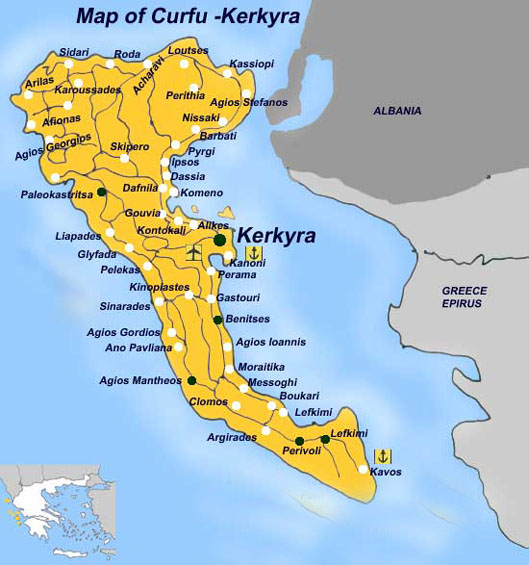
|
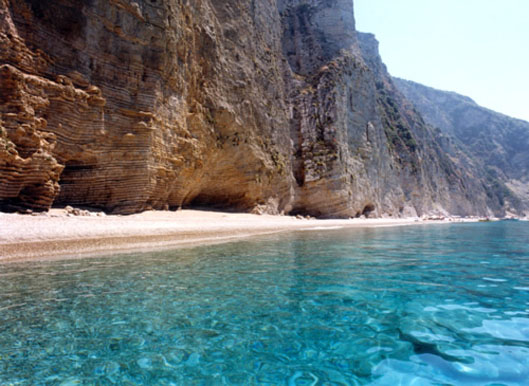
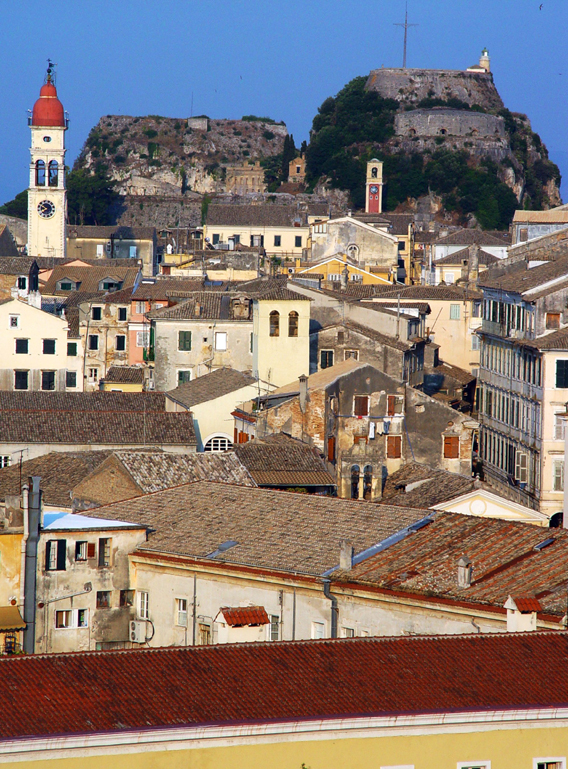

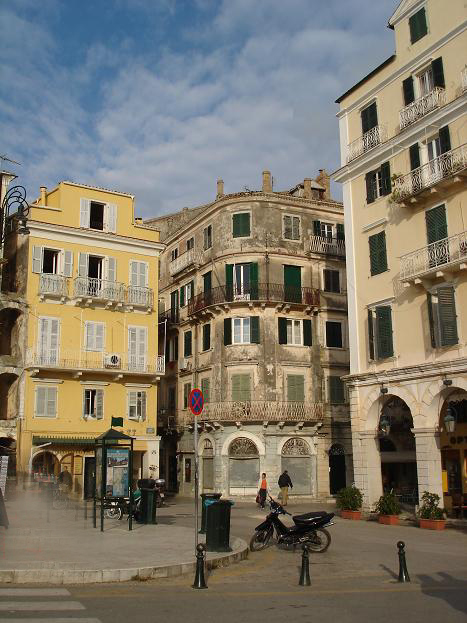


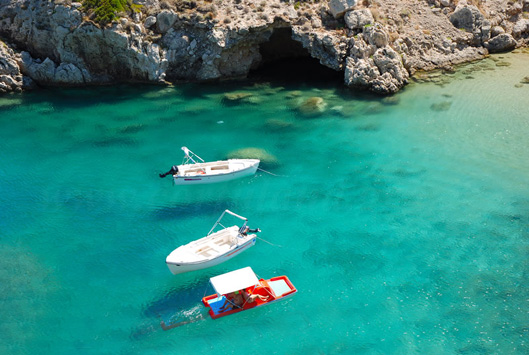

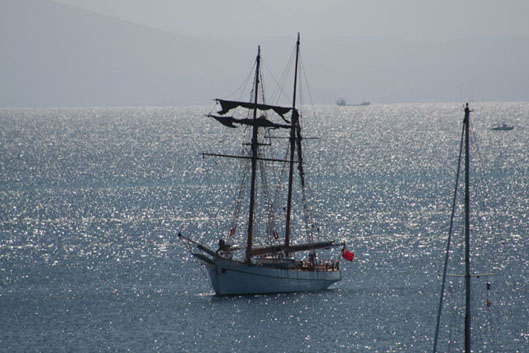
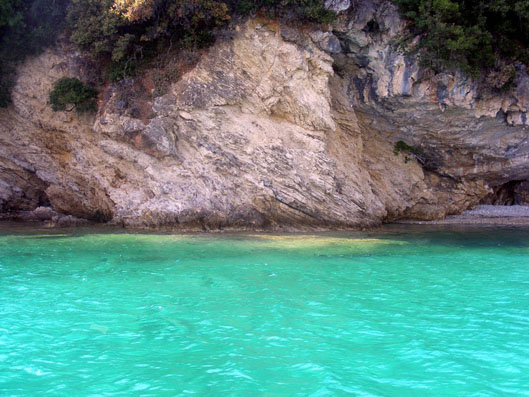
Add your content here
Η
ΧΩΡΑ
Η πρωτεύουσα και
το ομώνυμο λιμάνι του νησιού
βρίσκονται στο μεσαίο σημείο
της ανατολικής ακτής, απέναντι
από την Ήπειρο. Είναι η μεγαλύτερη
μεσαιωνική πόλη στην Ελλάδα
που κατοικείται ακόμα και
μία από τις όμορφότερες
της Μεσογείου. Η μείξη διάφορων
πολιτιστικών αγγιγμάτων
προίκισε αυτήν την επτανησιακή
πόλη με το μοναδικό ευγενές
περιβάλλον του, με μια ιδιαίτερη
γοητεία. Αρκετά συναρπαστικές
είναι οι ξένες αρχιτεκτονικές
επιρροές και οι διάφορες
διαταγές που συνδυάζονται
με τα τοπικά ιδιωματικά
χαρακτηριστικά γνωρίσματα
και το θεαματικό φυσικό
τοπίο, δημιουργώντας ένα
μοναδικό αισθητικό αποτέλεσμα.
ΑΞΙΟΘΕΑΤΑ
Η χώρα έχει
μια από τις μεγαλύτερες
πλατείες της Ελλάδος, την
εντυπωσιακή Σπιανάδα, της
οποίας η αριστερή μεριά
κυριαρχείται από το εκπληκτικό
κτηριακό σύμπλεγμα του
Λιστόν με τις διακριτές
αψίδες, σημείο συνάντησης
για ντόπιους και επισκέπτες.
Στη βόρεια πλευρά της ορθώνεται
το παλάτι του Αγ. Μιχαήλ και
Γεωργίου, το οποίο χρονολογείται
από την περίοδο των Εγγλέζων
(1814-1824), ενώ στα δυτικά δεσπόζει
το εντυπωσιακό και ενδιαφέρον
Παλιό Βενετσιάνικο Φρούριο,
χτισμένο τον 15ο αιώνα.
Ανάμεσα
στα αξιοθέατα το Νέο Φρούριο,
χτισμένο στο λόφο του Αγίου
Μάρκου τον 16ο με 17ο αιώνα και
τα κτήρια του Δημαρχείου
(17ος αι.), η Ιόνια Ακαδημία και
το Ιόνιο Κοινοβούλιο, η Αναγνωστική
Κοινωνία (το παλαιότερο
πνευματικό ίδρυμα της μοντέρνας
Ελλάδας) και η Παλιά Νομαρχία
(το κτήριο του Καποδίστρια
- 1832), το οποίο τώρα στεγάζει
τα γραφεία του Ιόνιου Πανεπιστημίου.
Αξίζει
τον κόπο να περιπλανηθείτε
στα βενετσιάνικα καντούνια
της παλαιότερης γειτονιάς
του Καμπιέλο, στα Μουράγια,
μια πανέμορφη παραθαλάσσια
γειτονιά της πόλης, στο Μαντούκι
κοντά στο νέο λιμάνι, στα
Ομβριακά, την παλιά εβραϊκή
περιοχή, στην πλατεία Σαρόκο,
το κέντρο της νέας πόλης,
στον κόλπο της Γαρίτσας,
όπου βρίσκεται το μνημείο
του Μενεκράτη.
Από εκκλησίες
η πιο διάσημη είναι αυτή
του Αγ. Σπυρίδωνα, πολιούχου
του νησιού. Επίσης η Παναγία
η Σπηλιώτισσα, η Αγία Θεοδώρα,
το μοναστήρι της Πλατυτέρας
στο Μαντούκι, το οποίο φιλοξενεί
τον τάφο του Ιωάννη Καποδίστρια,
η Παναγία των Ξένων και ο
καθεδρικός ναός του St. James στην
πλατεία του Δημαρχείου.
Επίσης
αξίζει να δείτε το Αρχαιολογικό
μουσείο, το μουσείο Βυζαντινής
και Μεταβυζαντινής Τέχνης
στην εκκλησία της Παναγίας
της Αντιβουνιώτισσας, το
Μουσείο της Ασιατικής Τέχνης
(στο παλάτι του Αγίου Μιχαήλ
και Γεωργίου) και το μουσείο
του Διονυσίου Σολωμού.
3
χιλιόμετρα από το κέντρο
της χώρας βρίσκεται το Μον
Ρεπό, αρχικά οι καλοκαιρινές
κατοικίες του Βρετανού
Κυβερνήτη και έπειτα το
καλοκαιρινό παλάτι της
ελληνικής βασιλικής οικογένειας.
Κοντά εκεί βρίσκεται και
η βασιλική της Παλαιόπολης
γνωστή ως βασιλική της Κέρκυρας.
Στον
λόφο της Ανάληψης, απομεινάρια
δορικού ναού από τον 6ο αιώνα
π.Χ. και η πηγή (Καρδάκι) όπου
βρέθηκαν το μοναστήρι των
Αγίων Θεοδώρων καθώς και
χαλάσματα του ναού της Άρτεμης.
Τέλος, νότια της χώρας υπάρχει
το πολυφωτογραφημένο μοναστήρι
της Παναγίας των Βλαχερνών,
το οποίο συνδέεται με μια
μικρή γέφυρα με το νησάκι
και σε μικρή απόσταση το
Ποντικονήσι με το Βυζαντινό
εκκλησάκι του Χριστού Παντοκράτορα
(13ος αι.).
Επίσης στο νησί μη χάσετε:
Στο Γαστούρι το υπέροχο
παλάτι της Πριγκίπισσας
Σίσσυ, το Αχίλλειον, τη Λεφκίμη,
το Κοντοκάλι με τα πολυτελή
ξενοδοχεία και εστιατόρεια,
στα δυτικά τους Περουλάδες
με την αρχιτεκτονική κληρονομιά
από την Βενετσιάνικη περίοδο
και την υπέροχη παραλία
"κανάλι της Αγάπης", το παραδοσιακό
χωριό της Κρήνης, κοντά στο
Βυζαντινό φρούριο του Αγγελοκάστρου,
την "Bella Vista" (όμορφη θέα). Σε ύψωμα
του γραφικού χωριού Πέλεκας
θα απολαύσετε το ομορφότερο
ηλιοβασίλεμα του νησιού.
ΠΑΡΑΛΙΕΣ
Το νησί προσφέρει επιλογές
και για τους πιο απαιτητικούς
κολυμβητές. Στα ανατολικά
από βορρά προς νότο έχουμε:
Κερασιά, Κουλούρα, Νησάκι,
Βαρβάτη, Δασιά, η ευρύτερη
περιοχή του Κομμένου, Μπενίτσες,
Αγιος Ιωάννης Σιδάρης, Πετρουλάδες
κλπ. Στα δυτικά από βορρά
προς νότο: Αρίλας, Παλαιοκαστρίτσα,
Ερμόνης, Μυρτιώτισσα, Γλυφάδα,
Κοντός γυαλός, Γιαλισκάρι,
Αϊ Γόρδης, Χαλικούνας κ.ά.
ΔΡΩΜΕΝΑ
Η λιτανεία του Αγίου
Σπυρίδωνα τέσσερις φορές
το χρόνο, η επέτειος της Ένωσης
του Νησιού με την υπόλοιπη
Ελλάδα (21 Μαϊου), ο εορτασμός
του Πάσχα με το παραδοσιακό
σπάσιμο των κανατιών, το
Καρναβάλι κ.ά.
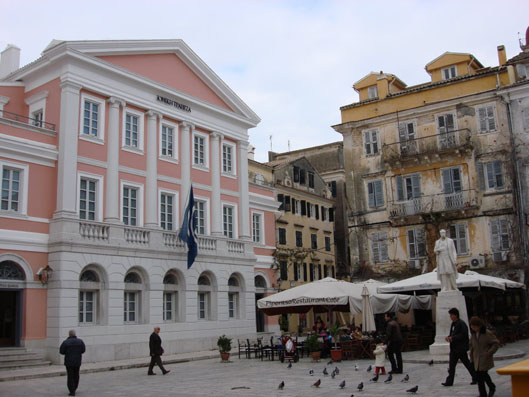
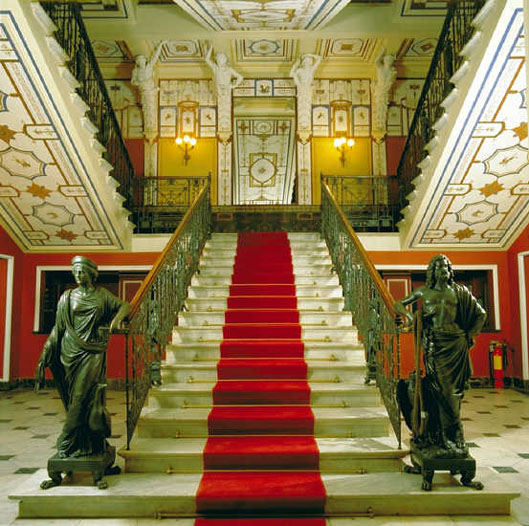
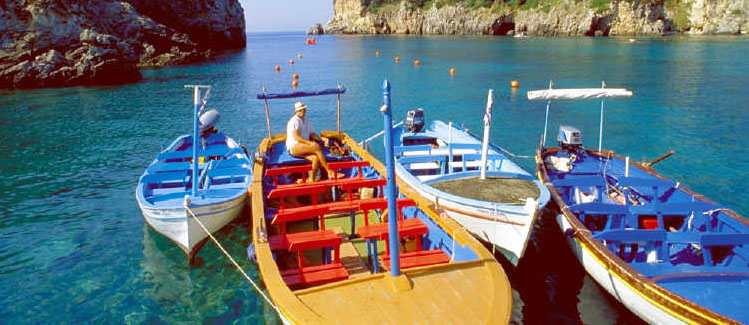
|

